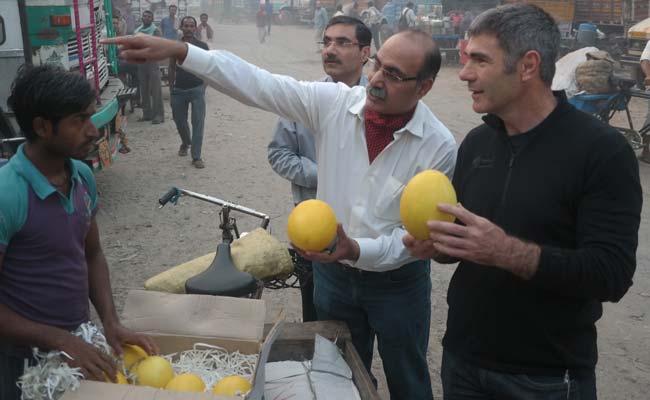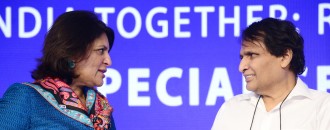
“We want to collaborate, not compete, with India”
New Zealand’s Primary Industries Minister Nathan Guy | The two countries are expected to resume negotiations on a Free Trade Agreement in a few months, after a gap of around 18 months Bidhu Bhushan Palo | @TheDollarBiz
 Mr. Nathan Guy (right) at the Ch. Hira Singh wholesale vegetable and fruit market in Delhi during his visit to India in November 2014 (Pic source – Govt. of New Zealand)
Mr. Nathan Guy (right) at the Ch. Hira Singh wholesale vegetable and fruit market in Delhi during his visit to India in November 2014 (Pic source – Govt. of New Zealand)New Zealand is considered a leader in sectors that India is now looking for growth: agriculture, dairy, hospitality and tourism. This, along with an ever growing interest among Indians to visit New Zealand, is changing the equations between the two countries. India’s importance for New Zealand exporters has grown significantly in the last few years. In the year ended June 2013, New Zealand’s exports to India stood at NZ$726 million (about US$600 million) of a total bilateral trade of around NZ$1.1 billion (about US$900 million). This is almost double the NZ$366 million (around US$280 million) worth exports to India in 2008. Today, India is New Zealand’s 12th largest export destination among the 160 countries it exports to. India’s young population is growing and the country is expected to become the world’s third largest economy in the next 10 years. New Zealand is keen to establish its presence in sectors such as food and dairy where demand is expected to surge in India in the coming years. Being New Zealand's second-largest source of international students, India is also a key services market for the country. As per available data there were 11,349 international fee-paying students from India in New Zealand in 2011, nearly double the number in 2008, and over 29,000 Indians visit New Zealand annually. New Zealand and India are both members of the Regional Comprehensive Economic Partnership (RCEP) negotiations, but the New Zealand government is keen to complete FTA negotiations with India, which will reduce tariff and non-tariff trade barriers on imports of agriculture products by India. At present, India’s imposes an average tariff of around 34% on agricultural goods from New Zealand. Under the FTA, New Zealand also targets to grow merchandise exports to India to over NZ$2 billion (about US$1.6 billion) per year by 2015, improve services trade with India by an average of 20% per year; and attract Indian talent to drive its economy. A 2009 joint feasibility study on the FTA says that phasing out of tarrifs on Indian imports – particularly in textiles, clothing and footwear, and industrial manufactured goods – would benefit Indian exporters. However, normally taking place in intervals of six months, the 10th round of Free Trade Agreement (FTA) negotiations has not taken place since July 2013. This could change soon, New Zealand’s Nathan Guy, Primary Industries (Agriculture) Minister, told The Dollar Business. He was recently in India with a trade delegation to strengthen bilateral trade ties and he wrote to us about his first visit to India. Excerpts: TDB: What are the key takeaways from your visits to India?
 Nathan Guy, Primary Industries Minister, New Zealand (Pic source - Govt. of New Zealand)
Nathan Guy, Primary Industries Minister, New Zealand (Pic source - Govt. of New Zealand)Nathan Guy: This was my first visit to India, and it is clear the opportunity and potential here is abundant. It was a very successful trip. I took the opportunity as the first New Zealand Minister to meet the new Modi Government to congratulate the Government on its election success. I also explained our recent economic record as a country, and highlighted the wealth of reciprocal opportunities between our nations. Our two nations have a longstanding and warm relationship. We share a Commonwealth heritage, legal system, business language and a commitment to democracy. New Zealand is also now home to over 155,000 Indians, who are a growing and important part of New Zealand’s society, economy and culture. TDB: What is the growth potential for bilateral trade between India and New Zealand? How will your visit help? Nathan Guy: It’s too early to put a dollar figure on this, but I’m confident it has helped open a lot of doors for the companies on the trip with me, and that increased trade will benefit both countries. India is New Zealand's 18th largest trading partner, and I believe there is great potential to grow two-way trade. TDB: What are the markets for Indian exporters to explore in New Zealand, and what are the ones importers here stand to gain? Nathan Guy: New Zealand is well known for our quality, premium food products. We are rightly famous for our lamb, seafood, dairy products, wine, fruit and vegetables and forestry products. We are also keen to share our expertise in the fields of agribusiness, IT, hospitality and tourism with India. New Zealand imports around $400 million of products from India, including pharmaceuticals, precious stones, textiles and motor vehicles. TDB: How do you see bilateral trade between India and New Zealand changing in the coming years? Nathan Guy: It’s important to reiterate that New Zealand is not aiming to compete with India – we don’t have the scale to do so. We export to around 160 countries and can only feed about 40 million people in total. What we are looking for is greater collaboration and cooperation across a range of business initiatives. TDB: What is the status of the FTA between New Zealand and India and how will it change bilateral trade? Nathan Guy: We have had nine rounds of negotiation on a potential FTA, and it's fair to say that the tenth round has taken too long to get going. I got a very strong indication from my trip that the Indian Government is keen to now see some progress, so that was one of the big exciting moves for me on the trip. It is likely that the 10th round of talks could start shortly. I’m optimistic it could be this year or the early part of next year. TDB: How do you think will bilateral ties between India and New Zealand change with the Cricket World Cup next year? Do you have any targets for Indian tourist numbers, trade meets, etc.? Nathan Guy: ICC Cricket World Cup 2015 is an opportunity for both countries to further grow their economic and trade connections. It will be a great occasion and I have invited several Ministers and economic leaders to come and visit New Zealand. TDB: Is New Zealand prepared to manage the inflow of Indians and other visitors during the 2015 Cricket World Cup? What are the preparations? Nathan Guy: Yes and we are looking forward to hosting visitors from countries all around the world. We have been planning for this major event for many years, and we’ll use our experience from hosting other major events like the Rugby World Cup 2011. TDB: What are your predictions for the 2015 Cricket World Cup? Nathan Guy: I’m always an optimist and I’m confident New Zealand will do well. I’m picking they will meet India in the final with the result too close to call.
This article was published on November 20, 2014.






 to success.
to success.